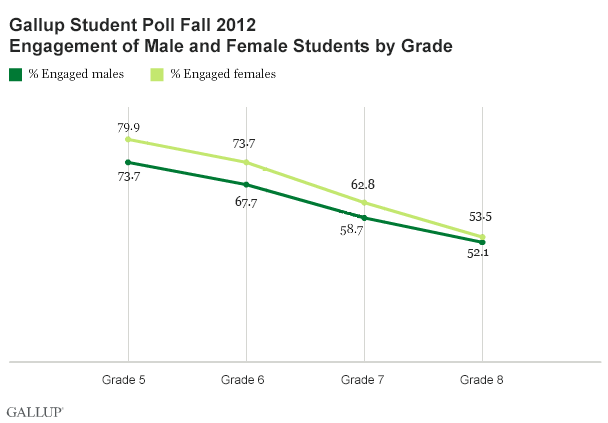America is failing our boys. Today's boys have lower aspirations for higher education than girls. While the disparity in interest in earning a degree appears when men and women are in their 20s, the problem may start as early as the fifth grade -- where more boys than girls become psychological dropouts.
Psychological dropouts are students who lose involvement in and enthusiasm for school. The number of psychological dropouts grows as students climb the K-12 ladder. At Gallup, we first discovered this through our Gallup Student Poll, an online measure of student opinions and characteristics associated with success and happiness. Two in 10 elementary school students who participated in the 2012 poll are not engaged or are actively disengaged with school. By middle school, it rises to about four in 10 students. And by high school, nearly six in 10 students are less than engaged.
Disengagement is clearly a problem for both boys and girls in American schools. But, Gallup Student Poll data suggest that boys have a weaker emotional connection with school as early as fifth grade. More than one in four boys are not engaged or actively disengaged in fifth grade compared with one in five girls. This engagement gap persists, but narrows throughout middle school. Then, in high school, school engagement for boys is about the same as girls. One interpretation of this finding could be that high schools re-engage boys in education. Closer inspection suggests that more girls become psychological dropouts with each passing year and they eventually match the disengagement of boys.

How do boys become psychological dropouts? The engagement items on the Gallup Student Poll start to tell the story. Boys have higher disengagement rates because they are less likely than girls:
- to receive praise and recognition for good schoolwork
- to consider school important
- to do what they do best every day
Given these findings, we could attribute the engagement gap to our school systems' failure to meet young boys' psychological needs for praise and meaning. We have essentially made school a place where boys don't want to be.
Student engagement drives school outcomes. Psychological dropouts then become real dropouts. Disengagement puts boys and girls at an academic disadvantage. Educators and policymakers need to develop strategies that prevent the engagement drop for all students, and they must find ways to close the boy-girl engagement gap during these important years. What can we do? Sure, we could tailor our efforts to boys, or girls, but we believe that strong, universally applied engagement strategies could do the job more effectively. Let's inspire engagement by:
Creating appropriate praise and recognition programs at school and home. Not every kid will get a trophy. But, every boy and girl needs to receive acknowledgment and celebration for the good work they are doing in school and for the unique contributions they make to their learning community. For tips on what works, read Carol Dweck's Mindset.
Linking schoolwork to a student's future plans. This will help make their daily attendance more rewarding. No one likes to work on stuff that doesn't matter and toward goals they don't find worthwhile. Make school relevant. Make the future come alive today for kids. For more perspective on this topic, take a look at Amanda Ripley's The Smartest Kids in the World.
Indulging students with opportunities to do what they do best. Knowing and using your innate talents -- strengths -- creates meaning. Focus on identifying what is right with students, and then help them understand how to use their strengths to do what they do best. Strengths development leads to hope and engagement. And these key factors drive their grades, retention, and future employment. For more insights, visit K-12 Education.
Keep this finding in mind -- more than one in four boys are psychological dropouts in the fifth grade. Girls are faring just a bit better. It is time we prioritize the student experience in middle and high school. It is time we become wholly dissatisfied with students' escalating disengagement with school. Let's figure out how to reach these children emotionally and academically.
Gallup Student Poll Methodology
Gallup offers its annual Gallup Student Poll at no cost to public schools and districts in the United States. The online poll is completed by a convenience sample of schools and districts each fall. Gallup randomly selects the schools participating. These schools are not given any incentives beyond receipt of school-specific data. Participation rates vary by school. Gallup conducts the poll during a designated survey period and available during school hours Tuesday through Friday only. Gallup administers the Gallup Student Poll to students in grades five through 12. In 2012, 479,439 students in U.S. schools participated in the Gallup Student Poll. The primary application of the Gallup Student Poll is as a measure of non-cognitive metrics that predicts student success in academic and other youth development settings.

